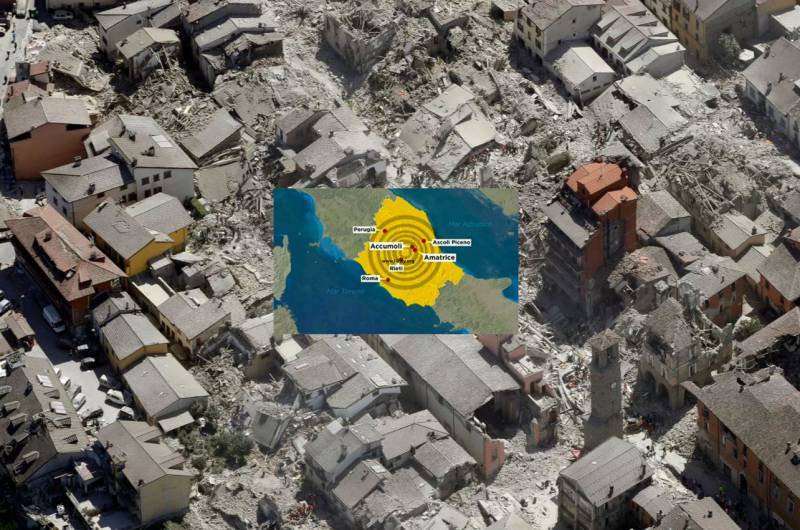Fragile Italy
The death toll from the quakes -- so far seven serious tremors have devastated these lovely ancient towns in the Central Appenines -- is over 240, and will doubtless increase. These are moments which bring out the best and worst of us, and you too can contribute.
ROME -- After seven devastating and another 460 lesser tremors -- the latest in the early afternoon Thursday -- wrought havoc in these lovely ancient towns in the Central Appenines, the death toll stood at 241 and is expected to increase. These are moments which bring out the best and worst of us. In one revealing incident, an obviously foreign youth with a slightly dark skin was seen digging madly with his bare hands into the rubble of a collapsed building. The police, calculating that he was a looter, arrested him.
In fact, he was one of a group of Afghan refugees who had been working in Amatrice, and were very much integrated and respected. He had been trying to dig out of the rubble, with his bare hands, two Afghan girls who, in fact, lost their lives. When the police realized the situation, they hugged and thanked him for his efforts.
The scattered quakes began just after 3:30 am Aug. 24 with a huge tremor whose magnitude was over 6. The quake was felt in Rome, where tall new buildings swayed, and Florence, two hours from the epicenter, but also farther away in Naples and Rimini. The towns hardest hit are, in a circle around the epicenter at Norcia, Arquata del Tronto, Pescara del Tronto, Amatrice, and Accumoli. Other tiny hilltop borghi also suffered collapsed buildings. To see the damage at Amatrice, take a look at the fire department's drone video: http://www.ansa.it/sito/videogallery/italia/2016/08/25/il-volo-silenzioso-del-drone-sulle-macerie-di-amatrice_f3747687-5fff-4843-8d29-bf9d9ab0f0bb.html
Rescue operations began when helicopers arrived just three hours later, with trucks and ditch diggers arriving as well despite the difficulties in driving to towns through roads blocked by fallen debris and rocks. In addition to the Civil Protection forces and police, 60 geologists from the four afflicted regions (the Marches, Umbria, Abruzzo and Molise) came onto the scene in order to evaluate the residual risks of landslides, superficial earth fractures and possible subsequent tremors. And 200 chefs from all over Italy have volunteered to come help feed those who lost everything and are in tents and improvised shelters.
For the emergency the government has already set aside E 50 million Volunteers came from as far away as Turin, and countless numbers are responding to the request for blood donors. Restaurants all over Italy are sending food, and the city of L'Aquila, itself half destroyed by a quake in 2009, has offered shelter to those in need. For private citizens anxious to make an offering, the Civilian Protection Department has set up a solidarity telephone number, 45500, to send Euros 2 automatically. The Catholic charity Caritas in the Diocese of Grosseto is also handling donations, see www.caritasgrosseto.org. In addition, donations can be made to Caritas Diocesana Grosseto - Banco Popolare – IBAN IT 77W05034 1430 200000000 4384
Two of those rescued told reporters that they had instinctively crawled under a bed as soon as they realized that the shaking of their building was caused by an earthquake. One of these was Sister Maria, 32, an Albanian nun. With blood trickling down her face, lying collapsed on a sidewalk, she was photographed speaking on her mobile phone to relatives, asking them to pray for the quake victims. She had been saved by "an angel," she related -- a young man who had been working in the hospice where she was living, and who risked his own life to save her and two others.
In the tiny ancient medieval town of Accumoli, not a single dwelling remains habitable for its 650 residents. Quakes had already taken their toll in 1997 and again in 2009, contemporary with the L'Aquila disaster. As a result, just five years ago its church of San Francesco was given a new bell tower to replace the one that had collapsed, but no steel beam was inserted for extra strength, and the tower again crumbled, "just like pieces of panettone," said one observer.
What of the future? "For years we geologists have been saying that Italy is still light years away from a culture of prevention," said Francesco Peduto today, president of the National Council of Geologists. Their goal, he specified, is to foster great risk awareness among Italian citizens, beginning in the schools. "Some studies show that from one out of five or even half the deaths are caused by people not knowing what to do during a seismic event." In addition, says geologist Raffaele Nardone of the Council, "In Italy at least 24,000 schools are in areas of risk. We simply must put the knowledge of geology at the center of territorial planning."
With luck, within a year the first satellite capable of advance warning of an earthquake will go into space, launched by China with a helping hand from Italian engineers. "The advance warning alarm will be possible thanks to an increase in cosmic rays at about five hours before the actual earthquake," according to Marco Casolino, researcher at the Rome University Tor Vergata, who worked on the initial development of the project together with scientisits from the Agenzia Spaziale Italiana (ASI) and the Istituto Nazionale di Fisica Nucleare (INFN).





































i-Italy
Facebook
Google+
This work may not be reproduced, in whole or in part, without prior written permission.
Questo lavoro non può essere riprodotto, in tutto o in parte, senza permesso scritto.